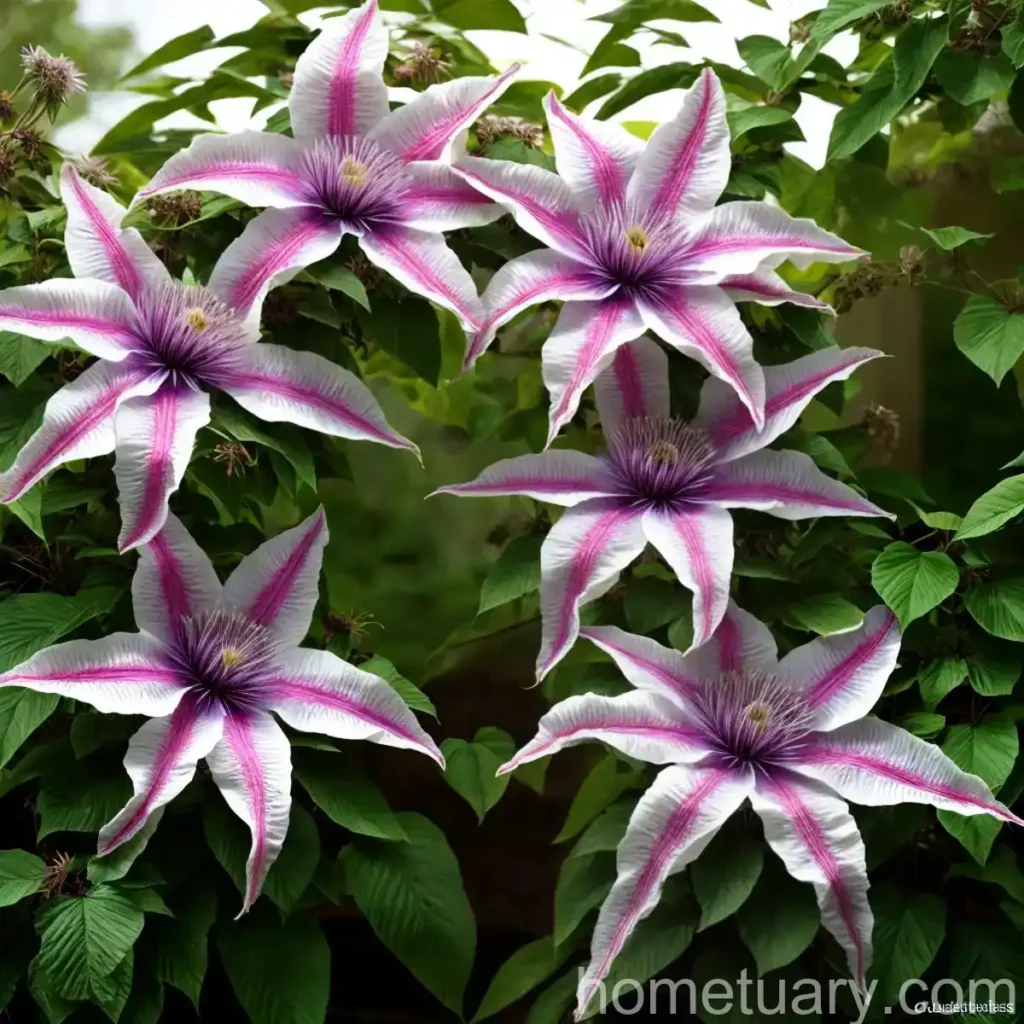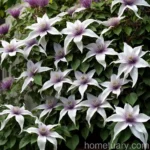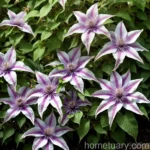Clematis Texensis: A Comprehensive Guide to Cultivation and Care
Clematis texensis, a stunning member of the Ranunculaceae family, is a truly captivating and enchanting flowering vine. With its delicate, nodding blossoms and twining habit, this plant adds an air of elegance to any garden or landscape. This comprehensive guide will equip you with the knowledge needed to cultivate and care for Clematis texensis, ensuring that it thrives and graces your surroundings with its beauty.
What is Clematis Texensis?
Clematis texensis, also known as Scarlet Clematis or Texas Clematis, is a woody, deciduous vine native to the southeastern United States and northeastern Mexico. It is renowned for its striking, bell-shaped flowers that bloom profusely in summer and early fall. The blooms, which can range in color from deep crimson to coral, are a magnet for pollinators, making Clematis texensis a delightful addition to pollinator gardens.
Key Takeaways
Before delving into the specifics of cultivating and caring for Clematis texensis, let’s outline the key takeaways encompassing its culture, uses, and essential requirements.
Culture
- Clematis texensis is a hardy and long-lived vine that thrives in temperate climates.
- It is well-suited to a variety of landscaping applications, from trellises and arbors to containers and mixed borders.
Uses
- This striking vine is frequently used to adorn fences, pergolas, and other vertical structures.
- Its abundant, nodding blossoms make it a sought-after choice for adding color and charm to gardens.
Essential Requirements
Water
- Clematis texensis requires regular watering, particularly during the growing season and dry spells.
Sunlight
- It thrives in full to partial sunlight, with at least 6 hours of direct sun per day being optimal for robust growth and prolific flowering.
Fertilizer
- A balanced, slow-release fertilizer applied in spring can enhance the vine’s vigor and blooming capacity.
Soil
- Well-draining, fertile soil with a slightly acidic to neutral pH is essential for healthy growth and development.
Pruning
- Proper pruning promotes flowering and maintains the vine’s shape, with different pruning requirements for various Clematis texensis varieties.
Propagation
- Propagation can be accomplished through methods such as layering, cuttings, and division, providing opportunities to propagate and share this exquisite vine.
Container Popularity
- Clematis texensis can thrive in containers, allowing gardeners with limited space to enjoy its beauty.
Clematis texensis Varieties
Before we delve further into the specifics of care and cultivation, let’s explore some notable Clematis texensis varieties, each bearing its own distinct charm and characteristics:
- ‘Duchess of Albany’: Boasting abundant, rosy-pink blooms, this variety is a captivating addition to any garden.
- ‘Gravetye Beauty’: With its rich, velvety red flowers, this variety adds a touch of opulence to the landscape.
- ‘Princess Diana’: Admired for its vibrant, deep pink blossoms, this variety is a radiant choice for enhancing the garden.
Clematis Texensis Pruning
Proper pruning is a vital aspect of Clematis texensis care, as it promotes vigorous growth and bountiful flowering. Pruning requirements can vary based on the specific variety and its blooming habits.
- Group 2 Clematis: Varieties such as C. texensis ‘Duchess of Albany’ belong to this category and require light pruning immediately after the first flush of flowers in early summer. This entails removing spent blooms and trimming back any unruly growth to a pair of healthy buds.
- Group 3 Clematis: Varieties like C. texensis ‘Gravetye Beauty’ fall into this category and benefit from more extensive pruning in late winter or early spring. At this time, the vine can be cut back to a few inches above the ground to encourage robust regrowth and prolific flowering.
Clematis Texensis Planting
When planting Clematis texensis, select a location that offers adequate sunlight, well-draining soil, and structural support for the vine to climb. Incorporate organic matter into the soil and position the plant so that its base is slightly below the soil level. This helps to protect the plant from harsh weather conditions and encourages strong root development.
Clematis Texensis Propagation
Propagating Clematis texensis provides an opportunity to expand your collection or share this captivating vine with fellow gardening enthusiasts. Several methods can be employed for propagation:
- Layering: Encourage the development of roots on a healthy, flexible stem by burying a section of it in the soil while it remains attached to the parent plant.
- Cuttings: Utilize semi-ripe stem cuttings to propagate new plants, ensuring that they receive adequate moisture and warmth to support root development.
- Division: Dividing mature Clematis texensis plants allows the creation of new, thriving specimens.
Clematis Texensis Flowers
Clematis texensis is celebrated for its captivating and distinctively shaped flowers, which draw the eye and captivate the senses. These charming blooms serve as a testament to the plant’s elegance and grace, making it a cherished addition to gardens and landscapes.
Clematis Texensis Growing Tips
To ensure the successful cultivation of Clematis texensis and the abundant production of its charming flowers, adhere to the following growing tips:
- Provide structural support for the vine to climb, such as trellises, arbors, or other vertical structures.
- Regularly water the plant, particularly during dry periods, to maintain adequate soil moisture.
- Apply a balanced, slow-release fertilizer in spring to support robust growth and blooming potential.
Clematis Texensis Sunlight Requirements
Clematis texensis thrives in environments that offer ample sunlight, with at least 6 hours of direct sun exposure being optimal for vigorous growth and prolific flowering. Plant this vine in a location that receives plenty of sunlight to ensure its health and vitality.
Clematis Texensis Soil Conditions
When cultivating Clematis texensis, ensure that the soil provides proper drainage and fertility to support the plant’s growth and development. Incorporating organic matter into the soil can enhance its structure and nourishing capacity, promoting robust growth and abundant flowering.
Clematis Texensis Water Needs
Regular watering is essential to maintain adequate soil moisture for Clematis texensis. During dry spells, pay particular attention to the plant’s water needs, ensuring that it does not endure prolonged periods of drought.
Clematis Texensis Pests and Diseases
While Clematis texensis is generally a resilient and vigorous plant, it can be susceptible to certain pests and diseases that may hinder its growth and flowering potential. Understanding these potential challenges equips you to address them effectively and safeguard the health of your Clematis texensis specimens.
Disease Diagnosis
When observing signs of disease in Clematis texensis, it is crucial to accurately diagnose the specific issue affecting the plant. Common symptoms of disease can include wilting, yellowing of leaves, or the presence of unusual spots or markings. Once the problem is identified, appropriate measures can be taken to mitigate its impact.
Common Pests
Clematis texensis may be vulnerable to pests such as aphids, spider mites, or slugs, which can feed on its foliage and compromise the plant’s health. Vigilance and proactive pest management efforts can help prevent these pests from causing significant damage.
Botanist’s Tips for Clematis Texensis Care
Drawing upon the insights of botanists and horticulturists can provide valuable guidance for successfully cultivating and caring for Clematis texensis. Incorporate these tips into your approach to maximize the health and beauty of your Clematis texensis specimens:
Fun Facts
- Clematis texensis is a favorite of hummingbirds, attracting these delightful creatures with its abundant, nectar-rich blooms.
- This vine is well-suited to vertical gardening, adding vertical interest and charm to landscapes and outdoor spaces.
Links to External Resources
In conclusion, Clematis texensis is a plant of exceptional natural beauty and graceful elegance. By adhering to the principles of proper care and cultivation outlined in this guide, gardeners can enjoy the abundant charms and striking allure of this captivating vine, ensuring its enduring presence in their landscapes and gardens.
With its vibrant blossoms, alluring fragrance, and mesmerizing charm, Clematis texensis is poised to captivate the hearts and imaginations of gardening enthusiasts, making an indelible mark on their outdoor spaces. Incorporate the insights and recommendations presented in this comprehensive guide as you embark on the journey of cultivating and caring for Clematis texensis, and revel in the splendor that this remarkable plant brings to your surroundings.















